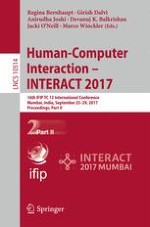2017 | OriginalPaper | Chapter
Improved Memory Elicitation in Virtual Reality: New Experimental Results and Insights
Authors : Joel Harman, Ross Brown, Daniel Johnson
Published in: Human-Computer Interaction - INTERACT 2017
Publisher: Springer International Publishing
Activate our intelligent search to find suitable subject content or patents.
Select sections of text to find matching patents with Artificial Intelligence. powered by
Select sections of text to find additional relevant content using AI-assisted search. powered by
